Boonville Bridge Video
Anniversary of the UP-MKT Merger
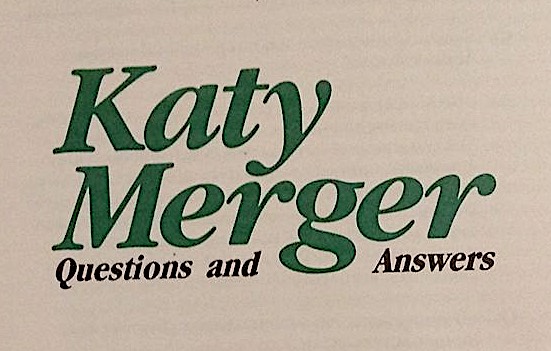
Today, 29 years ago, the Missouri-Kansas-Texas and Union Pacific Railroad merger was finalized.
I recently came across a flyer describing the Katy Merger, and found it very interesting. The photos are a bit blurry, so I have transcribed the text:
Why is Union Pacific acquiring Missouri–Kansas–Texas Railroad?
The M-K-T, commonly call the Katy, is a vital part of Union Pacific's main route between Kansas and Texas because of trackage rights agreements. Those agreements allow Union Pacific trains to run on Katy tracks. Because of Katy's increasingly difficult financial situation, Union Pacific is concerned about the future of those tracks. UP has trackage rights on 380 miles of Katy lines. Katy also has rights on some Unopn Pacific routes.
If Union Pacific has such trackage rights, why is a merger necessary?
The merger is critical for M-K-T. Already in a weak financial position, Katy faces a multitude of competitive pressures. Survival of M-K-T is vital to Union Pacific and to shippers in the Katy service area.
If Union Pacific has such trackage rights, why is a merger necessary?
There are significant differences in the competitive aspects between this merger and the parallel Santa Fe-Southern Pacific merger. While the Santa Fe-Southern Pacific merger would have reduced rail service to only one carrier in several markets without trackage rights for other railroads, no such major loss of competition will happen in UP-Katy service areas.
Won't a merger between Union Pacific and M-K-T reduce competition and cause increased rates?
Following the merger at least two and in some cases, three separate and independent rail systems will provide service between major points in Missouri, Kansas, Texas, and Oklahoma where UP and M-K-T operate. In addition there is substantial truck and barge operation in these markets.
What other railroads serve the M-K-T territory?
Other carriers in the market are are Kansas City Southern, Burlington Northern, Santa Fe, and Southern Pacific.
How will the merger help Katy shippers?
Union Pacific will upgrade and improve maintenance of Katy. Upgrading will involve rail programs, tie renewals and improvements to the signal system. Without the merger M-K-T could not make these needed improvements. A well-maintained railroad will benefit shippers through more reliable, efficient and safer service. Katy shipper will also gain single system service to West Coast ports, more Gulf Coast ports and major additional Midwestern gateways including Chicago and Memphis, and single line service to Mexico. They will also have access to Union Pacific's vastly larger freight car fleet (6,000 M-K-T cars compared with 77,600 cars on the Union Pacific). Union Pacific's financial strength will give M-K-T shippers long range transportation stability.
Will the merger benefit Union Pacific shippers?
The merger will guarantee key routes between the Midwest and the Gulf will be preserved and maintained to UP standards. The shorter routes will benefit Union Pacific shippers in parts of Kansas. For example Union Pacific will be able to reduce the distance between Salina, Kansas, in the middle of the grain belt, and Fort Worth by 118 miles.
Doe the merger include the former Rock Island line from Salina south to Dallas?
Yes. The merger includes the former Rock Island route now known as the Oklahoma, Kansas and Texas Railroad (OKT).
Will there be any abandonment as a result of the merger?
There is extensive overlap of operations and service between Union Pacific and Katy. Some segments of both Union Pacific and Katy will be abandoned. Other segments will simply change from primary to secondary main lines.
What will happen to employees whose positions are eliminated?
The merger will result in a substantial reduction in force. Employees whose positions are eliminated will likely be entitled to a variety of severance options. These options may include early retirement, severance payments, and in some instances, New York Dock labor protection routinely imposed by the Interstate Commerce Commission as a condition to the approval of railroad mergers.
What are the terms of the agreement?
Union Pacific will pay $110 million for the Katy and will assume $256 million in outstanding debts.
Why was the plan to acquire the Katy announced, then cancelled?
Union Pacific had reached an agreement in 1985 to acquire the Katy, but the deal was cancelled when the Katy was unable to acquire a specified number of registered certificates that had been issued when the railroad was reorganized in 1958. Under the terms of the certificates, the M-K-T is prohibited from paying dividends until 60 percent of the certificates are redeemed. A new offer to acquire a sufficient number of certificates has succeeded, allowing the agreement to go forward.
When will the merger take place?
By statue, the Interstate Commerce Commission has up to 31 months to act following the filing of a merger application. The application to acquire the Katy was filed Nov 14, 1986. Union Pacific requested the commission adopt an expedited schedule. The commission has approved this request with hearings scheduled to begin August 3, 1987. A decision is expected in early 1988.
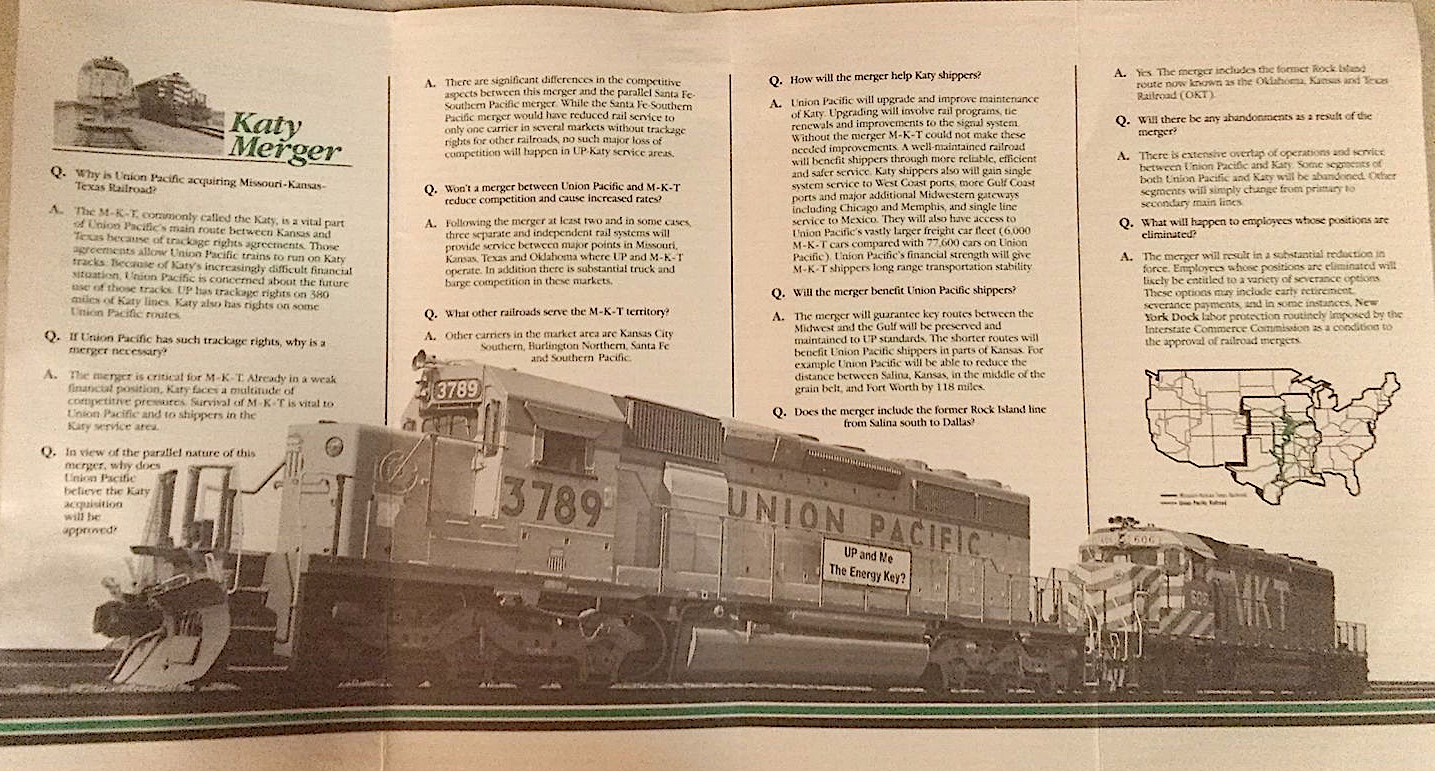
Database of cars from days gone by
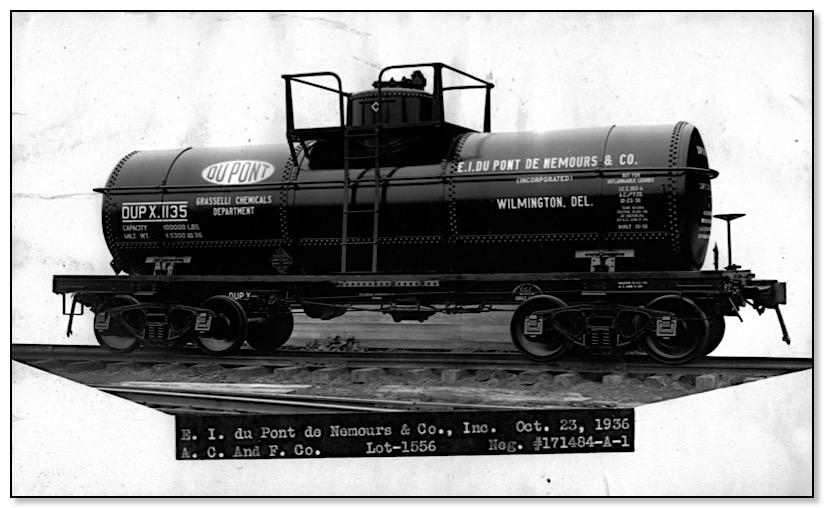
I came across this link in the online model train literature recently and am compelled to share it.
It is a flickr feed of cars from the American Car and Foundry (ACF) Company. The photos are part of the John W. Barringer III National Railroad Library photostream.
Great pics of a variety of cars from the past. It is a terrific modeling resource for those that model rail cars from the 1930's.
Link to photos
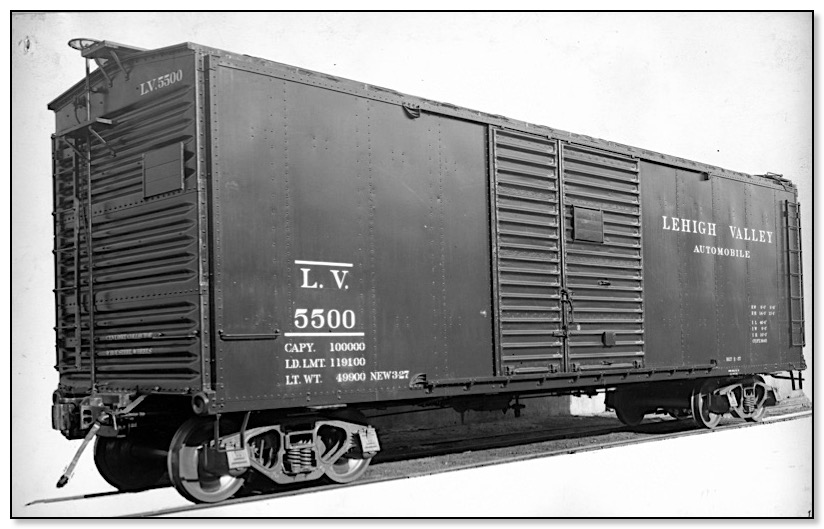
A simpler time, a simpler place...
Grain Elevator, Charles Konowal, National Film Board of Canada
Great photos of 1980 railfanning in KC
Switchlist for the Mighty MKT
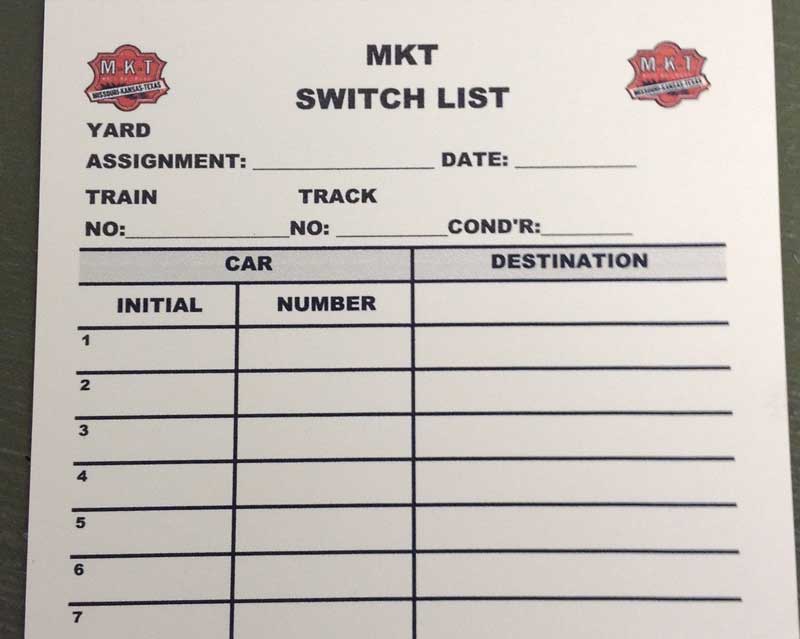
Many of my railroady friends like to use switchlists during operating sessions. I use them off-and-on, but generally prefer just to string the car cars out along the layout when I'm working a train (definitely NOT an Elite Operator™ habit!!).
For a long time, I copied a prototype switchlist that I found at a train meet, but I recent decided to make some Mighty MKT-specific switch list. I made a template in Microsoft Excel (using the prototype list as a guide) and printed the lists out on buff-colored card stock.
They look good, and add a nice custom touch to the layout.
I am switching cars WAY too fast!
I found the link to this video on Lance Mindheim's great web site. Especially his blog entry on capturing a sense of "mass"
It shows some great switching action and it gives a sense of the overwhelming mass of the cars and power required to move them. It is particularly enlightening to non-rail guys like me, who have no (or little) direct reference when it comes to switching cars.
In his blog, Mr. Mindheim discusses some of the things that modeler can use to capture this sense of mass in switching. In particular, he mentions:
- Layout height - the closer you get the models to eye level, the more realistic the viewing experience will be.
- Sound - capturing the visceral sense of mass using auditory inputs.
- Speed curves - using a broad range of control for slow speeds is achievable with today's decoders and programming tools (such as Decoder Pro)
- Decoder tuning - using Pulse Width Modulation and silent motor control to achieve the smooth slow-running operation required to simulate prototype switching.
I'm a bit of a lead-foot when it comes to switching - I guess that it's just my impatient nature. We tend to scoff at the really slow operators, saying that they are "milking the job" or something like that. But, actually, they have the right idea. The slower switching certainly duplicates the prototype and gives the illusion of mass that we are trying to achieve.
Who says you need a minimum 6-inch bench depth?
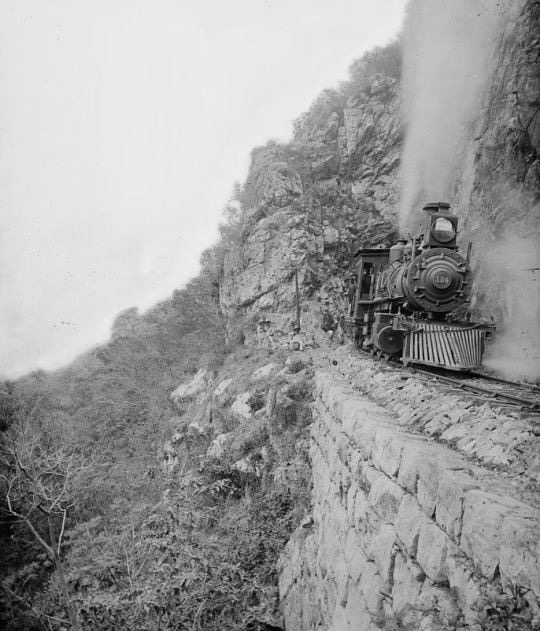
Train on a ledge, exiting Tunnel 8, Temasopo Canyon, Mexico, circa 1880-97/
Awesome Rainfan Mapping App
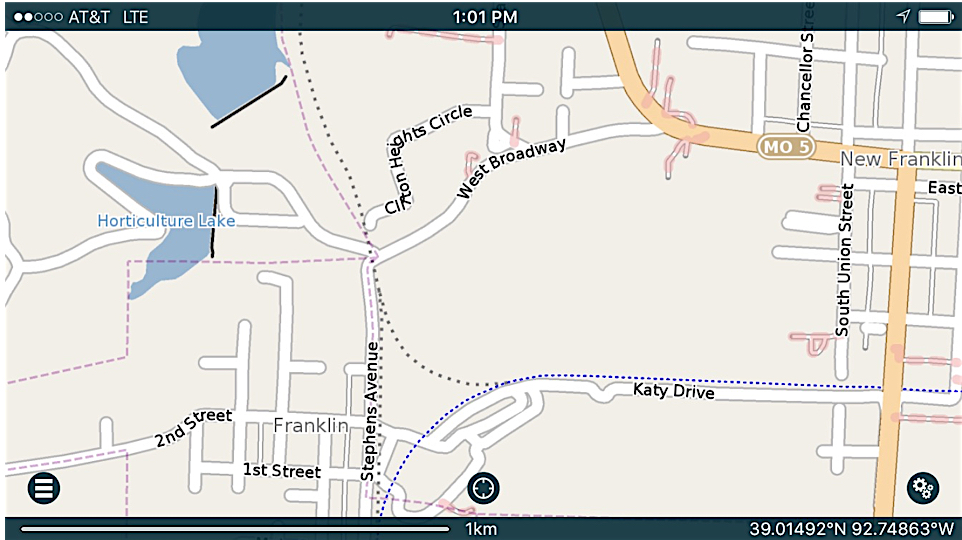
Here is a screen shot of Franklin, Missouri. You can see the existing Katy Trail, and the old track (long gone) of the MKT Hannibal Branch and wye.
I spent a fun afternoon with Joe and Steve, my two smart train buddies, rail fanning along the St. Joe Sub of the BNSF. Both Joe and Steve know this stretch of track like the backs of their hands, and Steve knows a ton about the history of the other railroad that used to be present in this area. We caught several trains running in both directions and generally had a great time (except where Joe almost got us all killed passing a slow-moving farm vehicle, but that is a story for another time).
During the trip, Steve showed me a great app for the smart phone. Pocket Earth Pro is a mapping app, similar to Apple Maps or Google maps. There are two benefits of Pocket Earth Pro over the traditional map tracker programs that are of particular interest to the foamer:
- You can download the map data and still use the program when you don't have a strong data signal (important for those "way out in the county" rail fan trips, and
- It shows the old, and abandoned rail lines
As a test, I looked at Paola, to see if the old MKT Osage Division tracks were included. They were! And those tracks have been abandoned since 1958! I'm planning a "walk in the woods session" for the Osage Division and this app will be crucial to planning that trip.
So if you are a rail fan, You need to give Pocket Earth Pro a look. The intro version is free, and the "PRO" version is $4.99. Worth every penny!
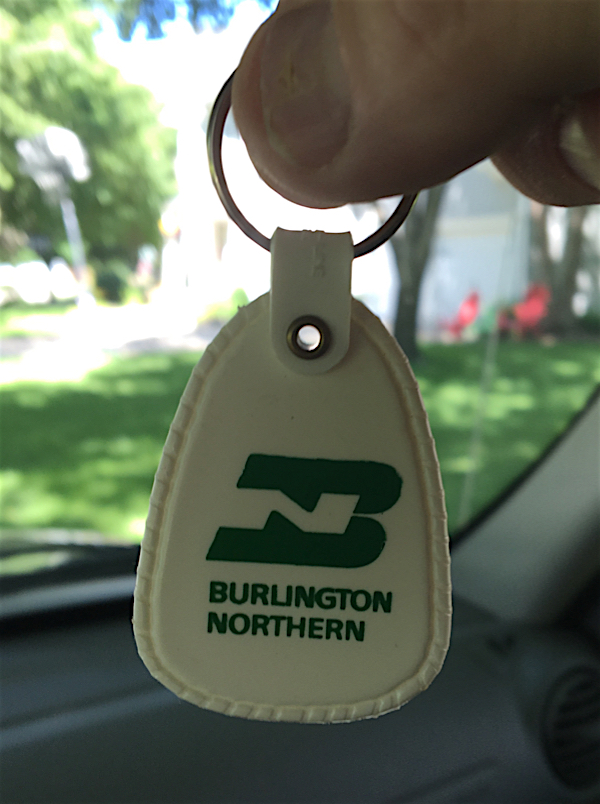
Sacred Talisman of Good Train Hunting, carried along on all rail fan trips! It has never let us down!
Alaska Railroad Cabooses on the Katy

I don't know much about them, but in the 1980', the MKT leased some Alaska cabooses. Here are a couple of pics.
It sure would have been crazy to see one of these hacks on the tail end of a Katy train in Missouri.
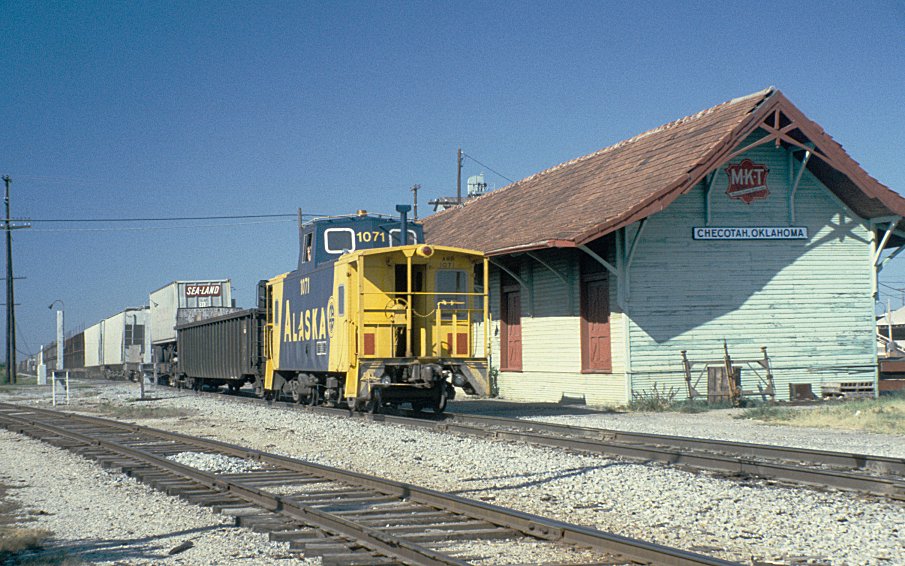
Shake what yer mama gave ya
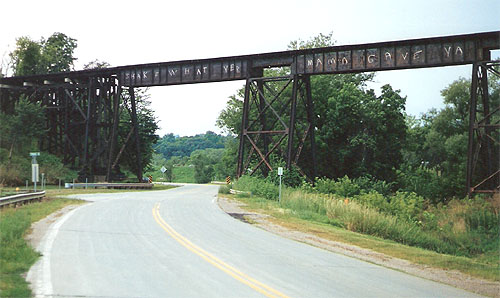
I grew up in the country west of Council Bluffs, Iowa. Our house was located off old Highway 6, and very near the old Rock Island line that ran from C.B. north to Avoca and on west to Des Moines and Chicago. The line was fairly active in the late-‘60s, but traffic petered out in the ‘70s. The Rock was shut down in 1980.
In 1984 the old Rock Island line out of Council Bluffs became part of the Iowa Interstate (IAIS) Railroad. For years, it ran a couple freight trains a day on the old Rock Track, but these days traffic is increasing with the addition of intermodal (!) traffic on this old and historic track.
A distinctive landmark on the old Rock Island track was the single track bridge crossing Old Highway 6 (McPherson Ave) and Little Mosquito Creek, just west out of Council Bluffs. This deck plate girder bridge was built in 1901, and has a total length of 320 ft. The longest span is 70 ft.
I passed under that bridge a thousand times when I was growing up. When I was in junior high, a friend challenged me to climb up and walk across the bridge, but I was too afraid to do it. Somebody had been up there, though, because the most distinctive feature of the bridge was the graffiti on the west side of the bridge, saying “SHAKE WHAT YER MAMA GAVE YA” in shaky letters. Every time I walked, or jogged, or biked, or drove under that bridge I tried to imagine that tag artist leaning over the tracks, writing those letters upside down! Yikes!
Several years ago, my parents moved to a new house, up the hill with a great view of the Mosquito Creek valley, the Iowa Interstate tracks and the bridge. Whenever I visit, I listen for the sound of the trains crossing the bridge. It sees a lot of action these days as the IAIS traffic continues to grow.
Alas, the graffiti has been painted over as part of a bridge approach upgrade project in 2014. But I still adhere to the advice that tag artist gave me those many years ago, and “shake what my mama gave me” as often as I can!.
Here is a link to more information at bridgehunter.com
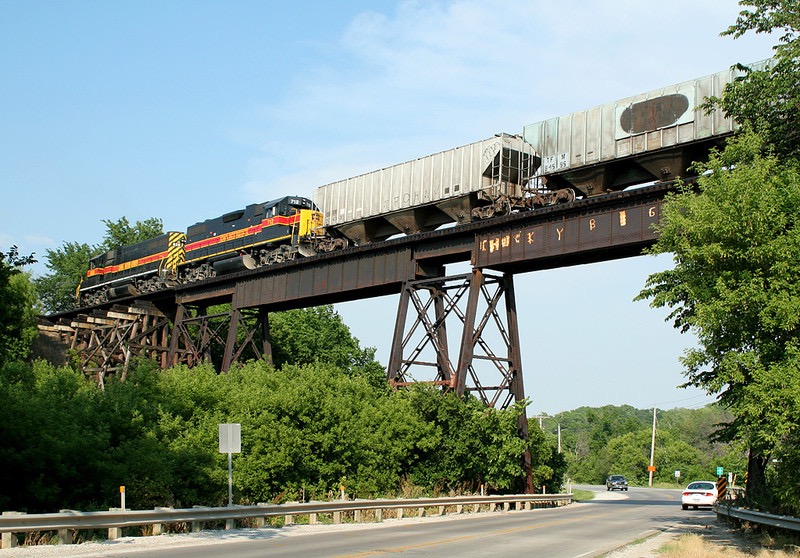
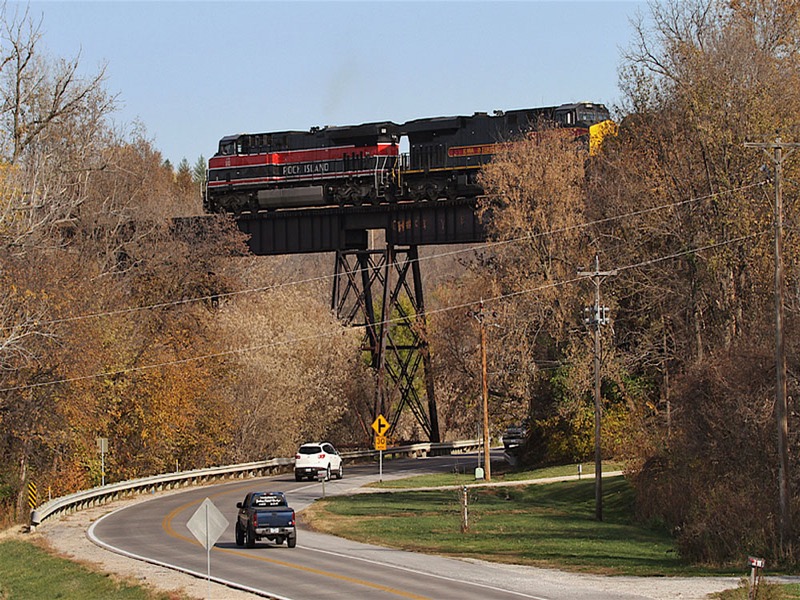
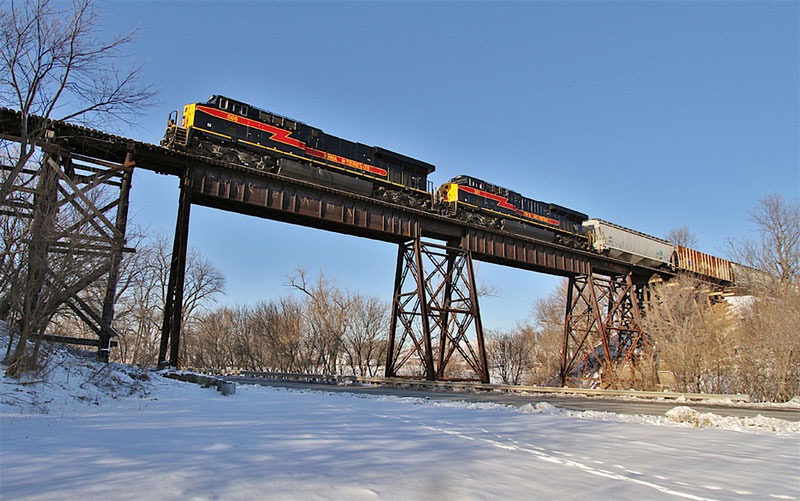
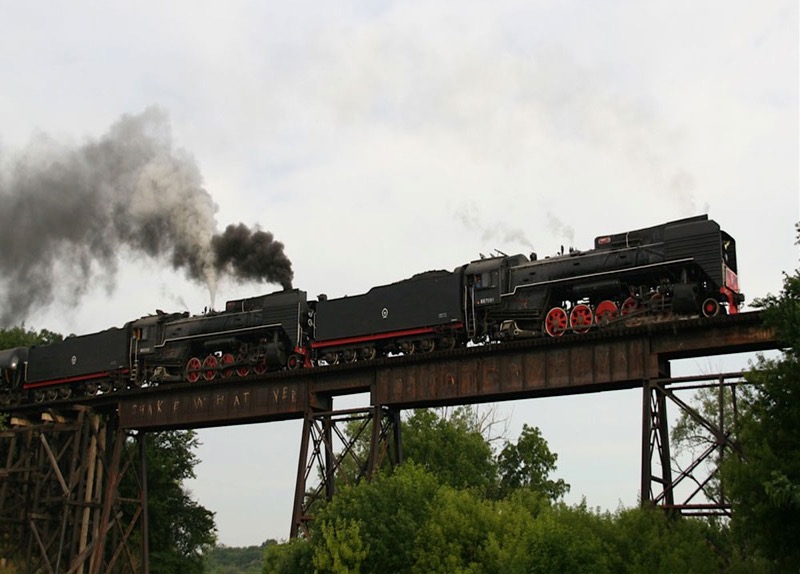
The Bryson Connector? Nope - The Osage Division
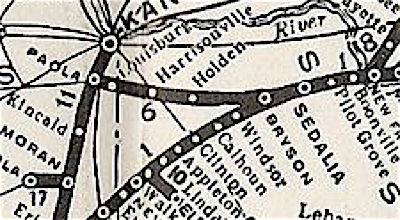
This is from the 1944 MKT System Map
Does anybody know anything about the track from Bryson, Missouri to Paola, KS?
This is from the history section of the Sedalia Depot Web Site:
Also in 1895, the MKT completed another new line from the St. Louis mainline at Bryson (north of Windsor) to the KC mainline at Paola, KS. This line was envisioned to serve as a through connector route for traffic between Kansas City and St. Louis, though its rather circuitous route made for long transit times and prevented the MKT from competing seriously in the trans-state rail market.
UPDATE!
Google is your friend. A few clicks into a search on the Google and I came up with TONS of info on the Osage Division of the MKT! (It was on the internets, so it must be true!)
This is from AbandonedRails.com:
The Osage Division of the Missouri, Kansas, and Texas (MK&T or Katy) Railroad began as a railroad known as the St. Louis and Santa Fe Railroad, Missouri Division which was incorporated on April 20th, 1869. Completed in 1871, the railroad was a single-track, standard gauge steam railroad that ran approximately 38 miles from Holden, Missouri (In Johnson County) to the Missouri/Kansas state line. As St. Louis and Santa Fe Railroad, Missouri Division quickly went bankrupt; the Katy Railroad officially completed purchased the charter on May 29th, 1872…
However, the connection to the mainline of the Katy did not ensure survival and the Osage Division (also known as the Holden & Paola line and possibly the Holden Division) closed in 1958. Today, the site of Bryson is marked by a sign on the Katy Trail with no mention of the Osage Division's existence. This portion of the Katy Railroad is not a part of the Katy Trail system in Missouri and was returned to the local residents, most of the railbird has been destroyed.
You gotta love the Google!
UPDATE #2!
I did a bit more research and ended up creating a page on this web site dedicated to the Osage Division.
Tres Chiflados
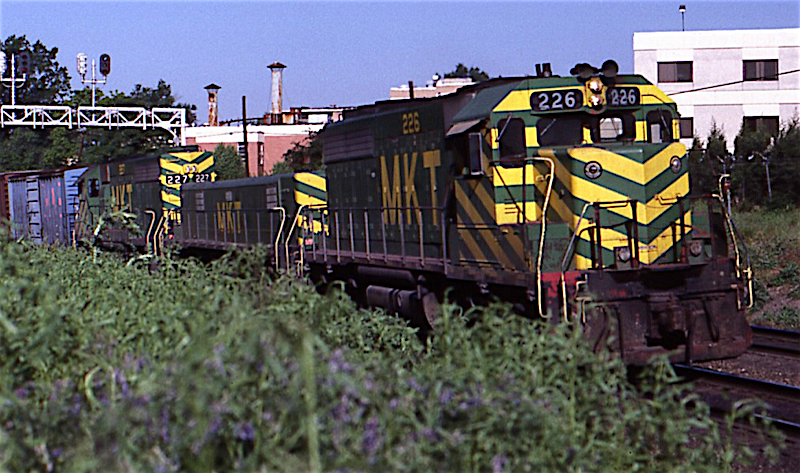
The Three Stooges in 1988.
This threesome of two GP40s (#226 and #227), separated by road slug #501, operated system wide as a single unit that was never parted except for heavy maintenance and had been christened "The Three Stooges" by train crews.
According to info from the MKT Yahoo list, the both 226 and 227 were set up as mother units, meaning that either could supply electrical current to the slug's traction motors, but it did not need both units in order to operate. The 501, having m.u. connections at either end, could still be used in any consist as long as either the 226 or 227 was with it.
MKT slug #501 was built from wrecked GP40 #222 in 1982 at the Parsons, Kansas shops.
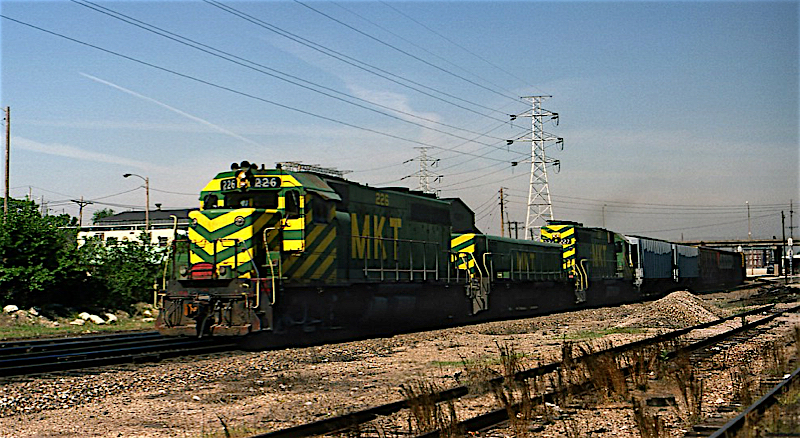
The three stooges in St. Louis in 1988
Piggy Packer Picked a Peck of Pickled Peppers
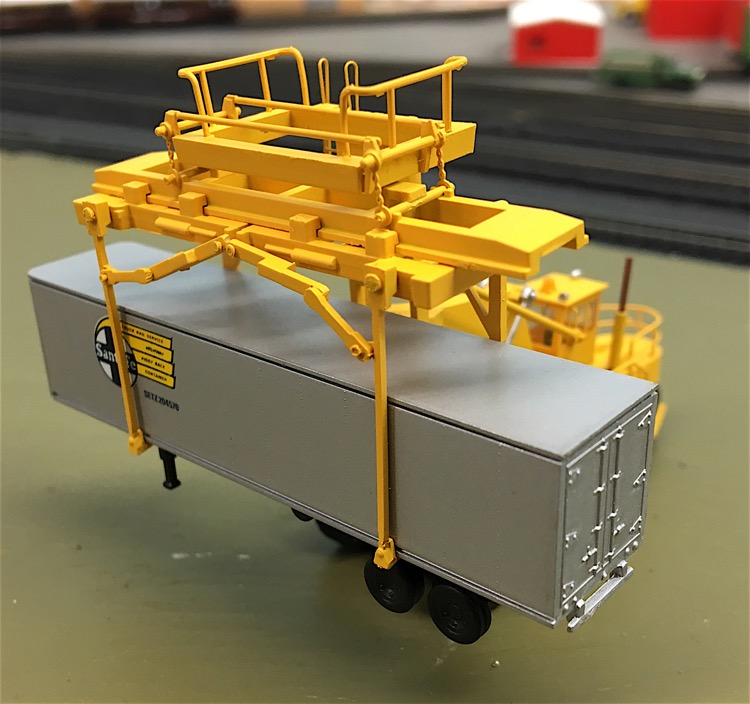
This thing arrived fresh from eBay the other day, and all I can say is it is GORGEOUS! What a great model - incredibly detailed. It's a Piggy Packer, which was used to load trailers and containers onto flat cars.
The model comes fully assembled from Wheels of Time (although mine arrived from eBay with both real wheels broken off - a quick fix with superglue and kicker).
I don't know much about the prototype. This is from the web site:
The PC-90 is a big machine. The front tires alone stand seven feet tall. The operator sits over 13 feet off the ground with an excellent view of the loading and unloading operation. Hydraulically operated boom and lift mechanisms make this machine very durable and robust. The Piggy-Packer typically loads an average of 12 trailers or containers per hour on to piggyback flat cars.# They come equipped with a spreader and bottom pick that handle both trailers and containers. In top-pick mode, they're able to stack containers three-high. The PC-90s could optionally be equipped with a spreader for lifting containers only.The PC-90 is powered by a Cummins NH-855C-250 6-cylinder diesel engine located under the operator’s cab. The Cummins engines have a four-speed transmission designed for maximum torque. They have a maximum rating of 250 HP at 2100 RPM. The PC-90 weighs over 80 tons and has a maximum speed of 27 mph ... not exactly swift.
It says that the machine was in operation from 1968 to the present, so it is chronologically correct for my 1984 time period. Alas, the MKT did not have any of them. But I'm invoking "Rule 1", and will place this model at the pig ramp (now a TOFC facility!) at the New Franklin Industrial Park. It will get some weathering and the "Norfolk and Western" marking must go, but generally, she is good to go for the layout!
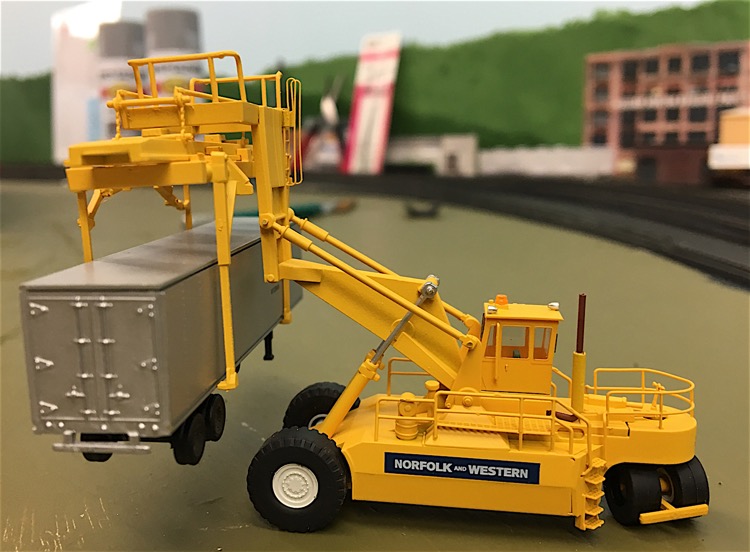
Guest Editorial tonight - The Katy into Lincoln!

Not really an editorial, but a link to a great article that I found on the interwebtubes, about the Missouri Pacific at Lincoln, Nebraska.
I was doing some online research about MKT's "Siberian Subdivision", which is what the Texas-based Katy crews call the Kansas City to Omaha/Council Bluffs/Lincoln track. In the 1980's, the MKT had trackage rights on the MP's line to the north.
This article has a paragraph about the MKT in Lincoln, but most of the story concerns the author growing up near the MP track. It is definitely worth a read:
http://www.trainweb.org/screamingeagle/history.html
